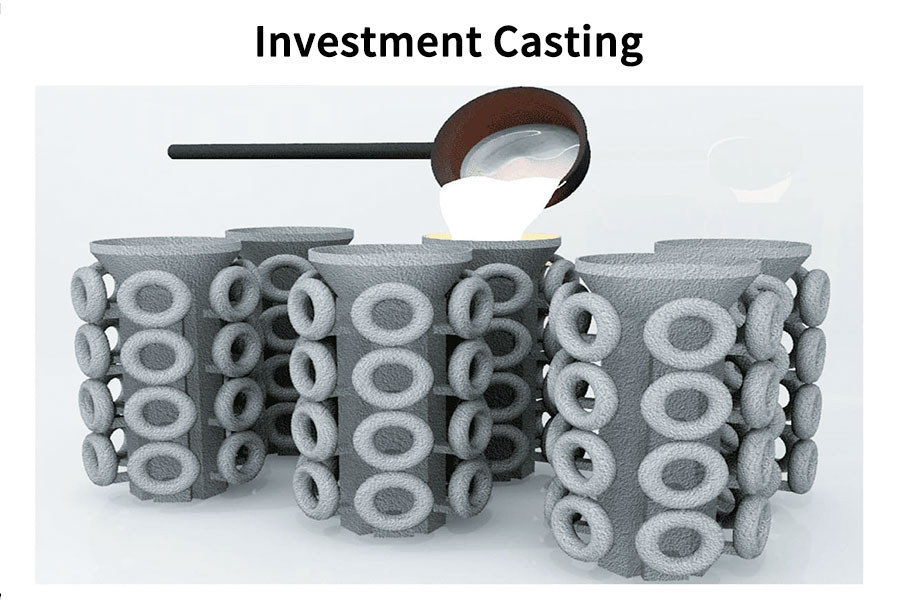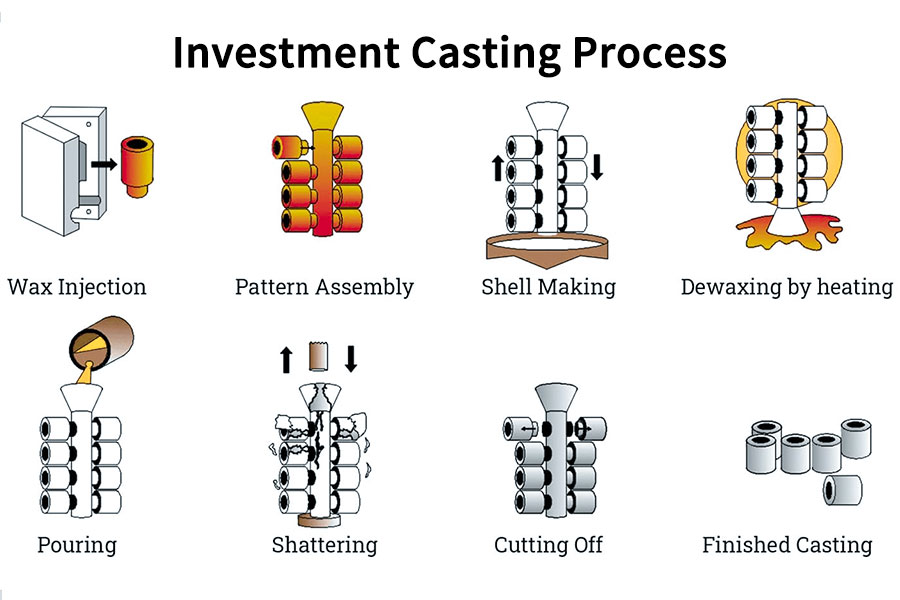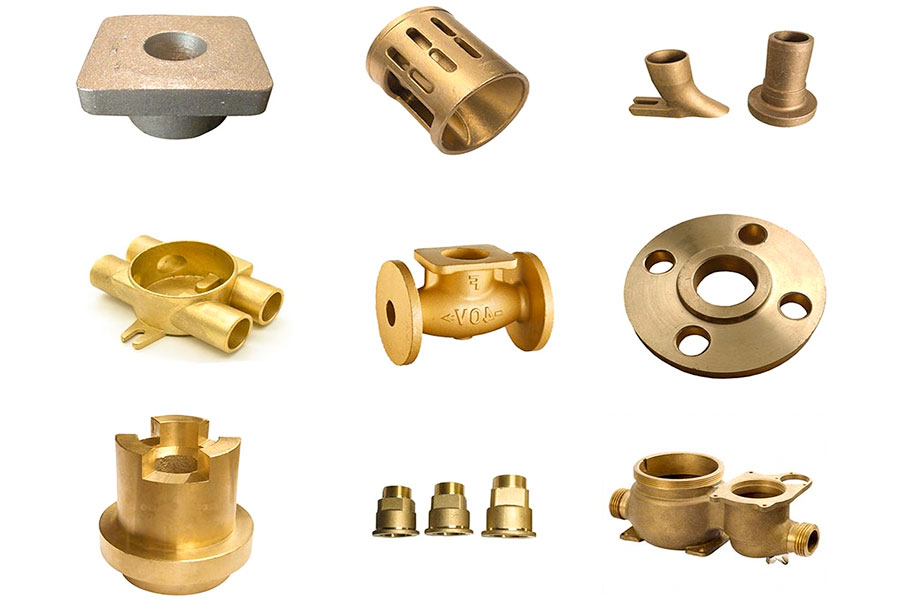Casting is one of the oldest manufacturing methods, with early processes dating back thousands of years and modern processes dating back to around 1893. While casting methods and techniques have improved greatly since then, the basic principles remain the same. Essentially, molten material is poured into a preform cavity or mold, where it cools and solidifies into the desired shape. LS uses different casting methods depending on the part and manufacturing specifications. One of the most common casting processes used in modern operations is investment casting. This guide will explore thebasics of investment casting, detailing its process and applications. By understanding its benefits, limitations, and applications, manufacturers can better evaluate whether this approach meets their production needs.
What is Investment Casting?
Investment casting, also known as lost wax casting or precision casting, is an advanced casting process mainly used to produce metal parts with complex shapes, precise dimensions and smooth surfaces. The core principle is to use fusible materials (such as wax, plastic, etc.) to first make a prototype model consistent with the shape of the final casting, and then coat the surface of the model with refractory materials multiple times to form a strong shell. When the mold shell is strong enough, the prototype model inside is melted and expelled by heating, leaving a hollow refractory cavity. Finally, molten metal is poured into the cavity. After the metal cools and solidifies, the shell can be broken to take outmetal castings with complex shapes and high precision.
Investment casting is widely used in aerospace, medical equipment, automotive industry, precision instruments and other fields because of its ability to produce high-precision, high-quality and complex-structured castings. It allows designers to create complex geometric shapes that are difficult to achieve with traditional casting methods, while ensuring the dimensional accuracy andsurface quality of castings. It is an indispensable precision manufacturing technology in modern industry.

What Are the Steps in the Investment Casting Process?
Theinvestment casting processis known for its high precision, high complexity and good surface quality, and is particularly suitable for producing small, complex-shaped metal parts. However, the process is also relatively complex and costly, so it is usually used in applications that have strict requirements on casting quality. Below we focus on learning and understanding the investment casting process, which mainly includes the following steps:
Steps 1: Creating the Die
The first step in the process is to create the die or pattern of the desired workpiece. The pattern is made from wax. It can be poured into a die usinginjection molding, carved by hand from a block of wax, or printed using a3D printerand the appropriate wax material.
Step 2: Mounting the Wax Patterns
Investment casting toolinginvolves creating multiple wax patterns and attaching these onto a “gate” device. This device is where metal or other materials will be poured to eventually create the desired workpieces.
Step 3: Tree Assembly
The tree assembly finishes the mounting of the wax patterns on the “gate” device. It is called a tree at this step because each individual wax pattern is essentially a “branch” and will be one finished workpiece once the process is finalized. You may have seen tree assemblies in new board games that need to have pieces detached before use.
Step 4: Shell Molding
Once the tree is assembled, the next step is to add theshelled castingaround it. First, the tree is dipped into a ceramic slurry. Then it is dipped into a stucco of fine sand. The molding must fully dry before it can be used. These two processes can be completed multiple times until the mold is thick enough to handle casting stresses.
Step 5: Wax Removal
Before the desired material can be poured into the newlyshelled mold, the wax patterns have to be removed first. This is often done by heating the wax inside an oven. Steam can also be used to heat the wax. The mold is placed upside down so that the liquid wax can flow out of it and be reused to create new wax patterns. An alternative process of wax removal is to heat the wax so that it “burns” off and is fully removed from the shelled casting.
Step 6: Mold Casting
After the wax has been removed, there will be open spaces inside the shelled casting in the shape of the formal wax patterns. Molten metal or another liquid material is poured into the casting. The material remains in the casting until it has fully cooled and solidified.
Step 7:Removal of Casting From the Mould
The divesting is typically carried out by hammering the mould to release the casting. Other methods to separate the metal casting from the mould include waterjetting, media blasting, vibration and chemical dissolution of the mould. The sprue, runners and other gating system components are then separated and recycled.
Step8 :Post-Processing Operations
The investment casting process generally does not require subsequent machining. However, if the results are not as expected, the casting may need surface finishing operations before use. Typically, surface grinding with machine tools is adequate for polishing and trimming any surface defects. Nevertheless, depending on the situation, other finishing processes such as hand tooling,welding, and hydraulic straightening may be necessary.

Comparability of Die Casting and Investment Casting
| Parameter | The Casting | Investment Casting |
|---|---|---|
| Design and Complexity | Appropriate for parts with intricate designs, skinny partitions, undercuts, and tight tolerances. Nevertheless, can’t produce as advanced parts as investment casting. | Provides better design flexibility, can solid advanced shapes, obtain exact dimensions, advanced geometries, and thin-walled parts. |
| Manufacturing Quantity and Price-Effectiveness | More cost effective for high-volume manufacturing runs. Increased volumes result in decrease per-unit prices as a consequence of economies of scale. | Costlier as a consequence of its extremely handbook process. Nevertheless, it may be cost-efficient for high-volume runs. |
| Dimensional Accuracy and Floor End | Produces parts with good dimensional accuracy and floor end. The smaller the casting, the better the dimensional accuracy. | Delivers superior dimensional accuracy and wonderful floor finishes. |
| Mould Utilization and Reusability | Molds in die casting are sometimes designed for long-term use, which might offset the preliminary excessive value over time. | Every distinctive casting run requires a brand new die to provide wax patterns. The wax used can often be recovered for reuse. |
Materials Used in the Investment Casting Process
The investment casting process is renowned for its flexibility in working with a wide range of metals and alloys, each chosen for specific properties to meet the demands of various applications. Commonly used materials include:
| Material | Properties | Environmental Suitability | Cost Considerations | Applications |
|---|---|---|---|---|
| Stainless Steel | High strength, corrosion resistance, durability | Excellent for harsh environments, high temperatures | More expensive, low-maintenance | Automotive parts, medical devices, golf club heads |
| Carbon Steel | High strength, good machinability | Suitable for general environments, low corrosion resistance | Cost-effective | Automotive components, machinery, construction hardware |
| Aluminum Alloys | Lightweight, good strength-to-weight ratio, corrosion resistance | Suitable for weight-sensitive environments, good corrosion resistance | More expensive than carbon steel | Aerospace, automotive components, electronics |
| Super Alloys | Exceptional mechanical strength, creep resistance | Ideal for high-temperature and high-corrosion environments | High cost, long-term durability | Gas turbines, aerospace, marine components |
| Copper Alloys | Excellent conductivity, corrosion resistance | Suitable for electrical and marine environments | Moderate cost | Electrical components, plumbing parts, decorative items |
| Brass | Good machinability, corrosion resistance, aesthetic appeal | Suitable for decorative and corrosion-resistant environments | Moderate cost | Valves, fittings, decorative items |
| Cast Iron | High accuracy, strength, heat resistance | Suitable for high-strength applications, may corrode in acidic conditions | Affordable | Engine components, pipes, machinery |
| Glass | Transparency, specific thermal properties | Specialized applications requiring transparency and thermal resistance | Higher cost due to complexity | Optical components, specialized containers, and lenses |
What are the applications of investment casting?
Investment casting has a wide range of applications, mainly reflected in the following aspects:
- Aerospace field:Investment casting technology can achieve very high dimensional accuracy and surface finish, and is especially suitable for producing castings with complex shapes and high precision requirements.In the aerospace field, it is widely used in the manufacture of key components such as engine blades and turbine disks.These parts have extremely high requirements for dimensional accuracy and surface quality, and investment casting technology can meet these needs and ensure the performance and reliability of the parts.
- Automobile manufacturing field:In the automobile manufacturing field,investment casting technologyis used to manufacture complex-shaped parts, such as engine blocks, steering gears, etc. These parts also have high requirements for precision and surface quality. Investment casting technology can provide high-quality, high-precision castings, thereby improving the performance and reliability of automobiles.
- Medical device manufacturing:In the medical field,investment casting technology is also used to manufacture delicate medical devicesand implants. These medical devices and implants have extremely high requirements for dimensional accuracy and surface finish to ensure their safety and effectiveness during use. Investment casting technology can meet these needs and provide high-quality, high-precision castings for medical device manufacturing.

Find an Investment Casting Company
For those looking to use investment casting in their projects, choosing the right partner is crucial. Whether you needaluminum, stainless steel, or titanium investment casting, it’s important to choose a company that meets your specific needs.
At LS we are a top provider of investment casting services. With years of industry experience and state-of-the-art manufacturing equipment, we have the knowledge, skills and tools to deliver quality rugged parts and products for the most critical industrial uses. To learn more about the differences between investment casting and die casting or our services and capabilities,contact us today.
FAQs
1.What are the basic principles of investment casting?
The basicprinciple of investment castingis to use fusible material (usually wax) to make a prototype mold, and then coat the surface of the prototype mold with multiple layers of refractory material to form a mold shell. After the mold shell is hardened and dried, the prototype mold is melted away by heating to obtain a hollow mold shell corresponding to the shape of the prototype mold. Finally, the molten metal is poured into the mold shell. After the molten metal cools and solidifies, the mold shell is broken and the casting is taken out.
2.What is the process flow of investment casting?
The investment casting process mainly includes the following steps: Making a prototype mold: Using wax or other fusible materials to make a prototype mold through injection molding, pressing, etc. Coating refractory materials: Apply multiple layers of refractory materials (such as silica sol, quartz sand, etc.) on the surface of the prototype mold. Drying and hardening are required after each layer of coating. Melting off the prototype mold: Put the prototype mold coated with refractory material into the roasting furnace and heat it to melt and discharge the prototype mold, leaving a hollow shell. Pouring molten metal: Pour molten molten metal (such as steel, aluminum, copper and other alloys) into the mold shell, and wait for the molten metal to cool and solidify to form a casting. Clean the castings: Break the mold shell, take out the castings, and perform necessary cleaning and processing.
3.What fields is investment casting suitable for?
Investment casting is widely used in aerospace, automobiles, medical equipment, industrial machinery, art manufacturing and other fields. Especially in the manufacture of components that require high precision, complex shapes and high-performance materials, investment casting offers significant advantages.
4.How much does investment casting cost?
Thecost of investment castingis relatively high, mainly due to the complex process and high cost of required materials and equipment. However, for castings with high-precision, complex shapes and high-performance requirements, the cost-effectiveness of investment casting is significant because it can reduce subsequent processing and scrap rates and improve production efficiency.
Summary
Investment casting is a precision casting methodthat involves making a fusible model, coating refractory materials, melting the lost model, baking the mold shell and pouring molten metal. After the metal cools and solidifies, the casting is taken out. The investment casting process provides modern industry with high-precision, high-quality and highly flexible metal forming solutions through its unique processes and technologies. The continuous improvement and innovation of this process will further promote its application and development in future industrial manufacturing.
Disclaimer
The content on this page is for reference only.LSdoes not make any express or implied representation or warranty as to the accuracy, completeness or validity of the information. No performance parameters, geometric tolerances, specific design features, material quality and type or workmanship should be inferred as to what a third party supplier or manufacturer will deliver through the Longsheng Network. It is the responsibility of the buyerseeking a quote for partsto determine the specific requirements for those parts.Pleasecontact usfor moreinformation.
LS Team
LS is an industry-leading companyspecializing in custom manufacturing solutions. With over 20 years of experience serving more than 5,000 clients, we focus on high-precisionCNC machining,sheet metal fabrication,3D printing,injection molding,metal stamping,and other one-stop manufacturing services.
Our factory is equipped with more than 100 advanced 5-axis machining centers and is ISO 9001:2015 certified. We provide fast, efficient, and high-quality manufacturing solutions to customers in over 150 countries worldwide. Whether it’s low-volume production or large-scale customization, we can meet your needs with delivery as fast as 24 hours. ChoosingLS Technologymeans choosing efficiency, quality, and professionalism.
To learn more, please visit our website:www.lsrpf.com
Resource
https://en.wikipedia.org/wiki/Investment_casting








